You are here
| Title | Date | Date Unique | Author | Body | Research Area | Topics | Thumb |
|---|---|---|---|---|---|---|---|
| Challenge of Recidivism to Counter-Radicalisation Programmes | January 28, 2022 | Saman Ayesha Kidwai |
For over a decade, counter-radicalisation programmes have been trying to de-radicalise and rehabilitate violent extremists and terrorists. Various countries have developed different counter-radicalisation programmes with varied results.1 In Britain, such programmes have been able to counsel, reclaim and rehabilitate several violent extremists and terrorists. In specific instances, the proportion of rehabilitated individuals is much higher than cases of recidivism2 when violent extremists, released by de-radicalisation-based institutions, have reverted to their violent ways. In recent times, recidivism has increased, as some of the released terrorists have carried out terrorist acts, including Ahmed Hassan (Parsons Green Bomber; 2017), Usman Khan (the London Bridge attacker; 2019), Kutjim Fejzulai (Central Vienna attacker; 2020), and Ali Harbi Ali (Murderer of Sir Amess; 2021).3 Usman Khan, for example, fatally stabbed two and wounded three people during the London Bridge Attack.4 Some international policy organisations such as the Counter Extremism Project, and think-tanks like the European Policy Centre, have expressed concern that certain individuals receiving therapy at counter-radicalisation centres may have learnt the art of deceiving the psychologists and in passing the tests conducted there to procure an early release from the prisons.5 This is concerning because, through disguised compliance6 , the terrorists portray to the authorities that they have been redeemed by the de-radicalisation programmes and have sworn off from committing terrorist offenses in the future. Traditionally, compliance involves altering behaviour at the behest of someone’s direction or request. However, in this instance, the act of submission presented by convicted individuals is simply a deceptive strategy. Furthermore, what is worrisome is that officials responsible for de-radicalisation programmes, such as Prevent (United Kingdom), have, in some instances, not been able to accurately assess those posing a grave danger to mainstream society. On the whole, the programmes are effective, but the possibility of some cases of recidivism would be there, because psychological and religious counselling can never be an exact science. However, Norwegian de-radicalisation programmes are a case in point because incidents of recidivism there amount to 20 per cent7 , one of the lowest worldwide. Counter-radicalisation experts such as Amanda Paul, have highlighted concerns about the competence of rehab professionals and their training. According to her, “the initial findings on disguised compliance determined that practitioners working on the frontline are poorly equipped and vulnerable to manipulation…the long-term political and human price of this is incalculable”.8 Such events have raised the question of whether or not de-radicalisation initiatives have any potential of success, and their scope in the states’ counter-terrorism strategies. However, this analysis does not argue for the scrapping of de-radicalisation programmes worldwide. These initiatives have proven instrumental in the success of Norway’s restorative-justice-based de-radicalisation programmes9 , India’s counter-terrorism initiatives in Kerala and Maharashtra, and Singapore’s de-radicalisation programme, which have been hailed for their efficient outcomes.10 Notably, this is a more desirable alternative than simply incarcerating radicalised individuals who could reform themselves by engaging with de-radicalisation experts. Moreover, while psychology is relied on to counter radical threats, it is understandably not a foolproof measure, more so because it is a recent phenomenon, requiring at least a few decades to mature and counter threats that have taken considerably longer to evolve and achieve their goals. Yet, if this is deemed insufficient by analysts, they ought to offer alternative solutions to counter challenges emanating from recidivism, beyond the traditional concept of prison sentences. Radicalisation: Learning From ExperiencesPrevent is a vital element of the British government’s counter-terrorism strategy to draw suspected individuals away from violent extremism. It was introduced by the Tony Blair administration in 2003. A strategy subject to severe criticism, it has come under deep scrutiny in the backdrop of the former Tory MP Sir David Amess’s murder in October 2021.11 The perpetrator had been referred to this programme seven years ago, but nothing materialised since it functions voluntarily, and the officials had not deemed him to be a threat serious enough to be referred to MI5, which deals with issues concerning domestic security and counter-intelligence. This ties together the two complex narratives re-enforcing each other in the terrorism and counter-terrorism domains. The duplicity and false compliance present within the radicalised individuals and convicted terrorist offenders pose a considerable threat to the society following their release. The report released by the International Centre for the Study of Radicalisation and Political Violence at King’s College, London attests to the veracity of such claims. Moreover, it claims that prisoners often use their time during imprisonment to reaffirm the commitment towards their cause, whatever it may be.12 Presumably, the violent extremists sentenced to prison or those recommended for de-radicalisation programmes could use this opportunity to undermine the security and law-enforcement apparatus from within while fomenting a similar ideological outlook among like-minded individuals or impressionable recruits during13 or after their farce rehabilitation. Re-examining Counter-Recidivism Agenda: Pitfalls and ProspectsThe professional counsellors reportedly perceive disguised compliance as an indication of severance of ties with violent extremist ideologies. However, this misplaced optimism can have cataclysmic repercussions for the overall community. The officials heading the de-radicalisation programmes outside prisons ought to approach the referred cases with similar caution. Although the lattermost has not committed terrorist acts, their ideological orientation could propel them towards inflicting violence in the foreseeable future. In both circumstances, terrorists and radicalised individuals could set in motion a chain of events wherein they could create an asymmetrical power dynamic vis-à-vis the state authorities. Through subterfuge, they could hoodwink the law-enforcement officials and mental health professionals, convincing the latter of innocence and commitment towards assimilation with the mainstream society, and adherence to the rule of law. This places the authorities in a significantly vulnerable position as they attempt to decipher and eliminate potential security threats within and outside prison environments. Admittedly, Islamist jihadists have carried out most of the recognisable terrorist activities in the modern world, and therefore, those adhering to radical interpretations of Islam should remain on the authorities’ radar. On the other hand, it is also relevant to consider factors such as criminals’ past and mental health crises to ascertain who could pose a greater security threat vis-à-vis others. This is crucial because these factors are often the underlying drivers of potential terrorist attacks, while the ideological orientation (Islamist jihadist or white supremacy) serves as the “rationalisation”14 for such acts. Before making a recommendation for an early release, the rehab professionals ought to account for these factors. The threat of reversion to terrorist activities by convicted offenders has remained around 5–8 per cent15 , according to a report released by the Radicalisation Awareness Network (RAN) in January 2021. However, the law enforcement and security agencies, and elected representatives ought to issue guidelines (in consultation with counter-terrorism experts and mental health professionals) to reassess the parameters governing existing early release programmes. The RAN is a European network of frontline workers—teachers, healthcare professionals and social workers—working with radicalised and potentially at-risk individuals. Since the same report also mentions that a high risk of re-occurrence of a terrorist act exists within the first few months of the prisoner’s release, it would therefore be advisable for the authorities to take caution while recommending early release, and do so in conjunction with stringent probation and regular monitoring—psychological and surveillance-based—to minimise the risk of recidivism. While there appears to be a dearth of information about the occurrence of similar events in India, those overseeing the de-radicalisation programmes, ought to overhaul their approach to prevent a similar chain of events within the country. It would be a cataclysmic failure for the security apparatus if the shifting geopolitical reality in South Asia (primarily Afghanistan) was to provide an ideological boost to those undergoing rehabilitation and in the process of being re-assimilated into the mainstream society, thereby causing their relapse. Moreover, India has borne the brunt of exported and home-grown threats such as Islamist jihad, left-wing extremism and separatist insurgencies over the years. Thus, it must learn from the European example. On the other hand, de-radicalisation programmes ought not to be dismissed just yet. The opportunity to turn the tide around and prevent further radicalisation by improving existing initiatives is an important point for consideration. The violent acts or lapses in de-radicalisation programmes ought to be understood by policy and security officials as learning experiences, significantly beneficial in preventing recidivism in the future. The authorities ought to also avoid treating a sociological problem such as this purely from a security or policy-based perspective. Views expressed are of the author and do not necessarily reflect the views of the MP-IDSA or of the Government of India.
|
Counter Terrorism | Radicalisation, Counter-Terrorism | system/files/thumb_image/2015/radicalisation-thumb.jpg | |
| Reducing Nuclear Dangers after the A.Q. Khanspiracy | September 2021 | K. Santhanam |
This article defines Pakistan’s brazen retailing of sensitive nuclear technologies as Bomb Process Outsourcing (BPO) and places it in a larger perspective. It offers a short retrospective of the development and manufacture of nuclear weapons by the P-5 in which significant manpower and materials were ‘foreign’. This is true of the programmes of Israel, Iraq, South Africa, Argentina and Brazil as well. Pakistan, has now, contributed to North Korea, Libya and Iran. This article is sceptical about claims made about the ‘successes’ posted under the non-proliferation or counter-proliferation regime and argues that Libya and Iran making a clean breast is due to economic-political-security accommodation between them and USA. It contends that the Pakistani BPO poses nuclear dangers more to Europe and Asia than USA. However, the establishment and the electoral system are fanning the BPO flames for short-term sectoral and political gains. The Pak BPO constitutes one of the most serious threats to international peace and security. To reduce the nuclear dangers posed by the Pak BPO, the article recommends immediate consideration by the Security Council and collective action under Chapter VII of the UN Charter. If the Council is deadlocked, an emergency session of the UNGAT could be convened. Additionally, an international conference needs to be convened as soon as possible on ‘Reducing the Nuclear Danger’. This was accepted at the Millennium Summit in September 2000. |
||||
| Islam and Sectarian Violence in Pakistan: The Terror Within | September 2021 | Zainab Akhter |
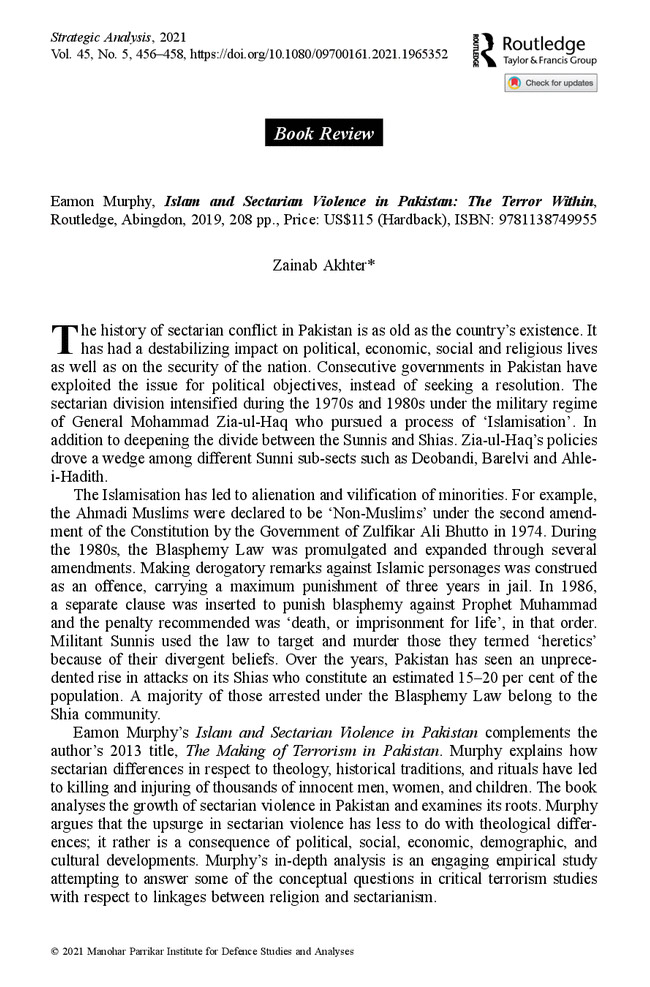
|
||||
| Hostility: A Diplomat’s Diary on Pakistan-India Relations | September 2021 | Amit Cowshish |

|
Defence Economics & Industry | |||
| The History of the Arthaśāstra: Sovereignty and Sacred Law in Ancient India | September 2021 | Medha Bisht |
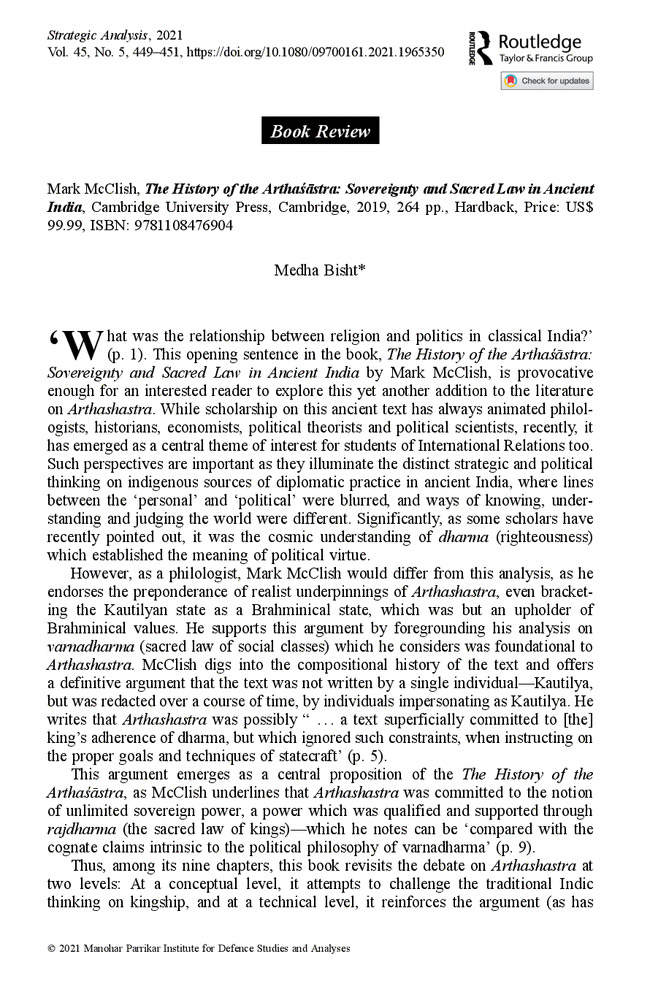
|
||||
| China and the World | September 2021 | Abhishek Verma |
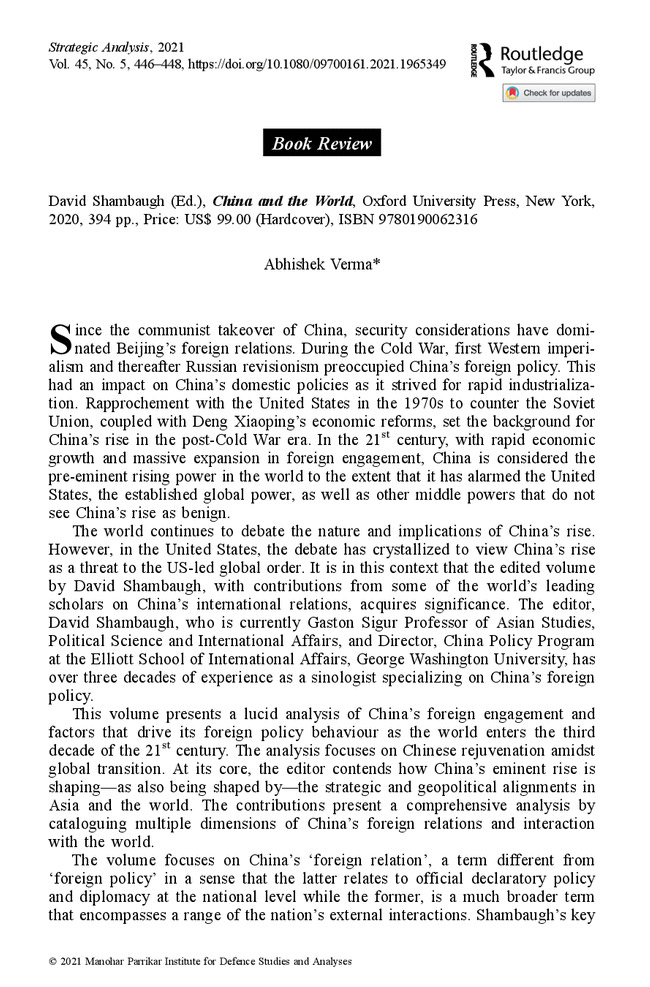
|
||||
| Vajpayee: The Years that Changed India ShaktiSinha, Vajpayee: The Years that Changed India, Penguin/Vintage Books, New Delhi, 2020, 368 pp., Rs.599.00 (Hardback), ISBN: 9780670093441 | September 2021 | Ahmed Raza |
Shakti Sinha, Vajpayee: The Years that Changed India, Penguin/Vintage Books, New Delhi, 2020, 368 pp., Rs.599.00 (Hardback), ISBN: 9780670093441 |
||||
| Climate Change and the Island States: Reimagining the International System | September 2021 | Lokendra Sharma |
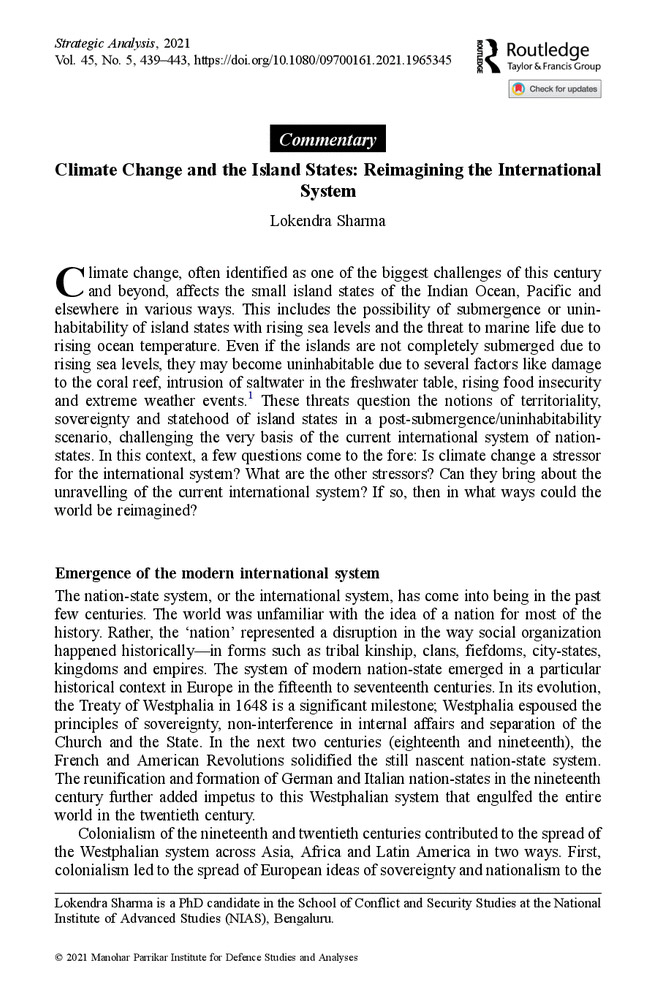
|
||||
| Renewed Push to Amend Japan’s Post-War Constitution: Prospects and Challenges | September 2021 | Shamshad A. Khan |
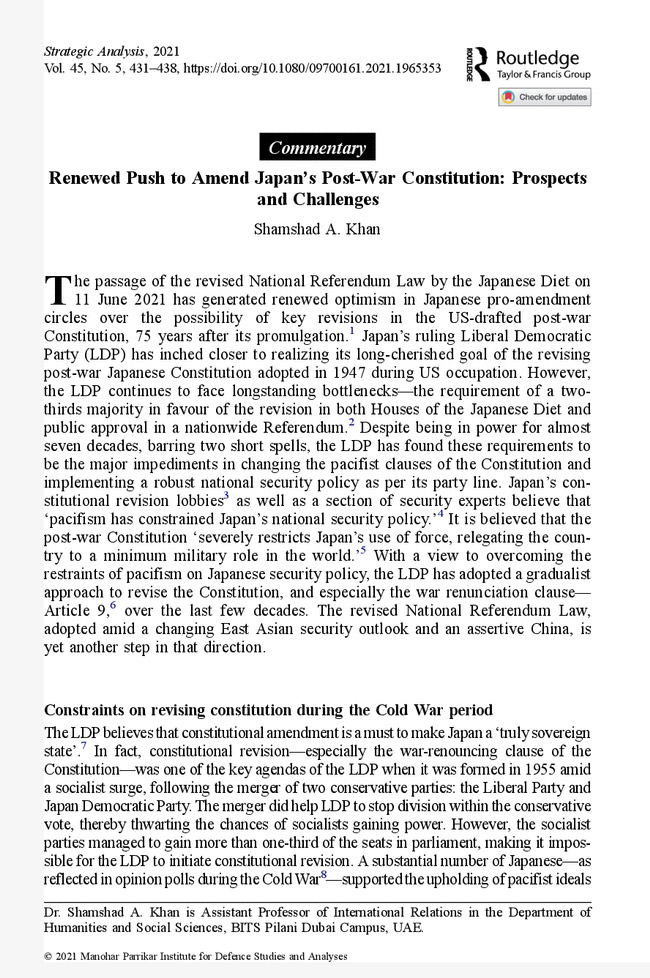
|
||||
| India–Australia: Defining New Horizons of Engagement | September 2021 | Pankaj K Jha, Shaun Star |
The landmark virtual summit between Prime Ministers Narendra Modi and Scott Morrison in June 2020 led to ties being upgraded to a Comprehensive Strategic Partnership. Australia’s High Commissioner to India alluded to the four D’s—Democracy, Defence, Diaspora, Dosti (friendship), with increased focus on Defence. In the India–Australia partnership, the emphasis is on maritime security cooperation, Quad 2.0, the Malabar exercises as well as cyber security and intelligence cooperation. The bilateral Mutual Logistics Support Agreement, and growing influence of China in the Indian and Pacific Oceans provide necessary impetus for the relationship to grow. The article outlines reasons for the growing bilateral relationship and the possible future trajectory. |
